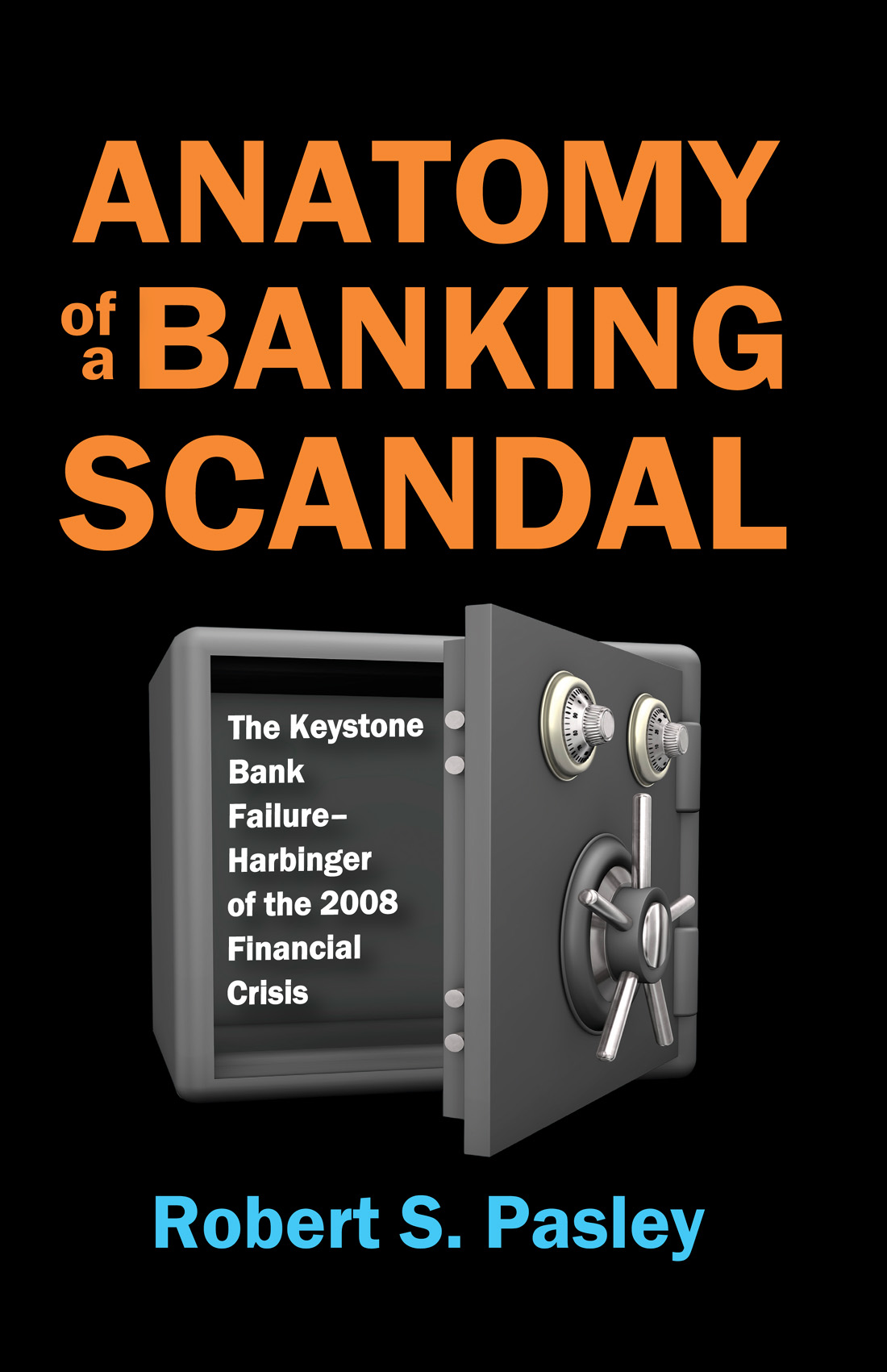Contents
ANATOMY OF A BANKING SCANDAL
ANATOMY OF A BANKING SCANDAL
The Keystone Bank Failure-Harbinger of the 2008 Financial Crisis
Robert S. Pasley

First published 2016 by Transaction Publishers
Published 2017 by Routledge
2 Park Square, Milton Park, Abingdon, Oxon OX14 4RN 711
Third Avenue, New York, NY 10017, USA
Routledge is an imprint of the Taylor & Francis Group, an informa business
Copyright 2016 by Taylor & Francis.
All rights reserved. No part of this book may be reprinted or reproduced or utilised in any form or by any electronic, mechanical, or other means, now known or hereafter invented, including photocopying and recording, or in any information storage or retrieval system, without permission in writing from the publishers.
Notice:
Product or corporate names may be trademarks or registered trademarks, and are used only for identification and explanation without intent to infringe.
Library of Congress Catalog Number: 2016006375
Names: Pasley, Robert S., author.
Title: Anatomy of a banking scandal : the Keystone Bank failure--harbinger of the 2008 financial crisis / Robert S. Pasley.
Description: New Brunswick : Transaction Publishers, [2016] | Includes bibliographical references and index.
Identifiers: LCCN 2016006375 (print) | LCCN 2016013541 (ebook) | ISBN 9781412862790 (hardcover) | ISBN 9781412863346 (pbk.) | ISBN 9781412862295
Subjects: LCSH: First National Bank of Keystone (W. Va.) | Bank failuresUnited States--History. | Banks and banking--United States--History. | Subprime mortgage loans--United States-- History. | Financial crises--United States--History.
Classification: LCC HG2613.K494 F577 2016 (print) | LCC HG2613. K494 (ebook) | DDC 332.1/2230975449--dc23
LC record available at http://lccn.loc.gov/
2016006375
ISBN 13: 978-1-4128-6279-0 (hbk)
ISBN 13: 978-1-4128-6334-6 (pbk)
To my beautiful wife, Gay, and to our two wonderful daughters, Virginia and Heather.
Contents
This is a true story about a bank failure in 1999. The case involved a series of unusual characters who caused the banks failure and engaged in a dizzying array of fraud and deceit. The fraud included embezzlement, bank executives stealing from one another, and even cooking the books to cover up massive losses from the securitization of subprime mortgages. The bankers yelled and screamed at the bank examiners, lied to their own attorneys and auditors and threatened a series of lawsuits. They hired fake bodyguards to intimidate the examiners; brought an injunction against the regulators based on forged emails; wrote threatening letters to the banking agency supervising the bank; and even buried bank documents in a large ditch outside of town to avoid them from being discovered by the examiners. The banks failure was also a harbinger of the 2008 financial crisis, but it went mostly unnoticed and understudied.
The bankthe First National Bank of Keystonewas a tiny bank located in an economically depressed area of an already poor stateWest Virginia; not too far from where the Hatfields and McCoys feuded.
The people running the bank were able to grow it from $17 million in total assets to over $1 billion. Along with this growth came amazing earnings. For three years in the 1990s, the bank was touted as the most profitable large community bank in the entire countryout of more than 5,000 similarly situated banks. It was phenomenal.
It was also fraudulent.
None of the numbers were real.
The banks purported earnings came from the securitization of subprime mortgages. The earnings were so great that the management of the bank was able to embezzle millions of dollars from the bank without being noticed. They hid their embezzlementand the much larger fraud related to the securitizationsfrom the federal bank examiners, its shareholders, the outside directors, and the nationally prominent auditors and attorneys working for the bank.
There were three primary managers of the bank: Knox McConnell, Ms. Billie Cherry, and Ms. Terry Church. McConnell became the president of the bank in 1977, and brought along his lifelong companion and secret lover, Cherry.
Church came with the pair in 1977 and became the senior executive vice president of the bank. Even though Cherry became the president of the bank after McConnell died in 1997, Church was the person who actually ran the bankand had been running the bank even prior to McConnells death.
McConnell and Church grew the bank by getting it involved in the securitization of subprime mortgages between 1993 and 1999. However, none of the securitizations was profitable and the bank was falsifying its books to hide this fact. Ironically, the bank was assisted first by Lehman Brothers and then Bear Stearnswho reaped huge fees, knowing that the securitization deals were worthless.
When the bank finally failed in 1999, the FDIC thought it would be one of the ten largest bank failures since the Great Depression. It turned out to be the sixty-ninth largest failure between 1934 and the present, out of more than 4,000 failed banks.
As the result of the frauds, numerous civil and criminal cases were brought in the aftermath of the banks failure. One criminal case was brought against Cherry and three criminal cases were brought against Church. They were convicted or pled guilty in all of the cases. Cherry died in prison. Church was released from prison in September, 2015.
The bank ended up as the subject of congressional hearings and an Inspector Generals review. In spite of the riskiness of the banks line of business, and the stark and surprising failure of the bank, the regulators and Congress failed to adequately learn from the lessons the failure of this bank could have taught, especially in connection with the subsequent 2008 financial crisis. There are, however, more lessons that could still be learned.
This book is based primarily on court records - depositions, sworn testimony at trial and court exhibits, as well as congressional hearings, scholarly books and interviews of people involved in the case. The book also draws from material obtained through the Freedom of Information Act, including banking agency memoranda, letters, reports of examination, and even suspicious activity reports filed with the Department of Justice. The original manuscript contained a myriad of footnotes to all of this, but the footnotes were too voluminous and made it too distracting to read, so most of the footnotes were eliminated. Explanatory footnotes and footnotes related to copyrighted and congressional sources have been kept. The quotations in the book are primarily from sworn testimony in court cases and depositions. Rather than repeating alleged, or it was testified that or court records reflect throughout the book, the reader should understand that that is the case and read the book accordingly. When I have drawn conclusions, I have done my best to provide reasonable interpretations of the record, primarily from cases in which the defendants in issue were found to be guilty of crimes or civilly liable for their alleged wrongdoing.
This project has been a very long one and there are a number of people and entities I would like to thank for their assistance, guidance and good wishes. They include the following:






